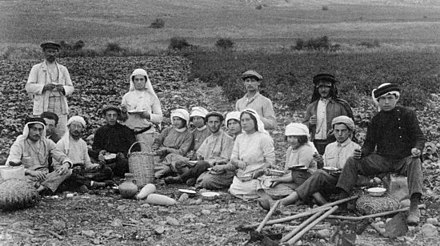Collaboration
Collaboration (from Latin com- "with" + laborare "to labor", "to work") is the process of two or more people, entities or organizations working together to complete a task or achieve a goal.[1] Collaboration is similar to cooperation. Most collaboration requires leadership,[vague] although the form of leadership can be social within a decentralized and egalitarian group.[2] Teams that work collaboratively often access greater resources, recognition and rewards when facing competition for finite resources.[3]
Structured methods of collaboration encourage introspection of behavior and communication.[2] Such methods aim to increase the success of teams as they engage in collaborative problem-solving. Collaboration is present in opposing goals exhibiting the notion of adversarial collaboration, though this is not a common use of the term. In its applied sense, "[a] collaboration is a purposeful relationship in which all parties strategically choose to cooperate in order to accomplish a shared outcome".[4] Trade between nations is a form of collaboration between two societies which produce and exchange different portfolios of goods.
Trade began in prehistoric times and continues because it benefits all of its participants. Prehistoric peoples bartered goods and services with each other without a modern currency. Peter Watson dates the history of long-distance commerce from circa 150,000 years ago.[5] Trade exists because different communities have a comparative advantage in the production of tradable goods.
The Roman Empire used collaboration through ruling with visible control, which lasted from 31BC until (in the east) 1453CE, across around fifty countries. The growth of trade was supported by the stable administration of the Romans.[6] Evidence shows that the Roman Empire and Julius Caesar were influenced by the Greek writer Xenophon's The Education of Cyrus on leadership.[6] This says that ‘social bonds, not command and control, were to be the primary mechanisms of governance’. Classics professor Emma Dench notes that the Roman Empire extended its citizenship "to enemies, former enemies of state, to people who’d helped them. The Romans were incredibly good at co-opting people and ideas."[7] The Romans created a stable empire that benefitted both ruled and allied countries. Gold and silver were currencies created by the Romans which supported a market economy, leading to trading within the Roman Empire and taxes.[clarification needed]
In Hutterite communities housing units are built and assigned to individual families, but belong to the colony with little personal property. Meals are taken by the entire colony in a common long room.[8]
The Oneida Community practiced Communalism (in the sense of communal property and possessions) and Mutual Criticism, where every member of the community was subject to criticism by committee or the community as a whole, during a general meeting. The goal was to remove bad character traits.[9]



